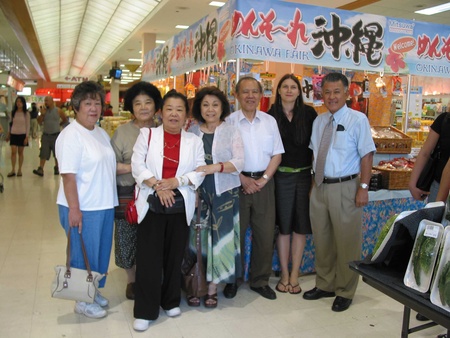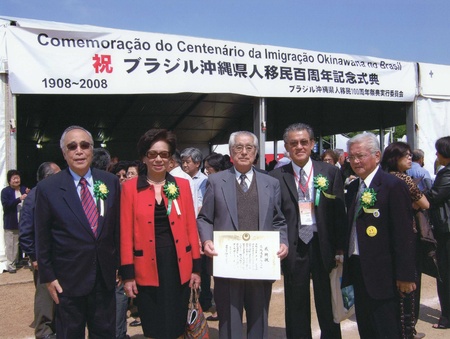Planning a food event at a U.S. military base in Okinawa
I think it was around 2005 when I first met Yoshihiro Tome, who is involved in the food import business from Japan, including Okinawa, in Los Angeles. Koichi Takeuchi, the publisher of the Japanese magazine "TV FAN," introduced me to him, saying that "an acquaintance of mine from Okinawa was looking for someone who could write." After that, I wrote reports on events that Tome held, and also accompanied him on business trips to Okinawa in response to his request to learn more about Okinawa.
I first came to Okinawa in 2008. Having previously served as a commissioned representative for Okinawa Prefecture, Tomei had a very wide network there. He had the opportunity to interview not only prefectural government officials, but also the tourism bureau, local food manufacturers, and even Hiroko Nao, a professor emeritus at the University of the Ryukyus who is an expert on Okinawan food culture, and Mitsuko Higashimon, the mayor of Okinawa City at the time.
What was impressive was a meeting held inside the US military base. They were planning to hold an Okinawan food event inside the base, with the aim of familiarizing US military personnel with Okinawan food culture during their time in Okinawa. The inside of the base is a completely different world from the crowded buildings outside the fence. The buildings are scattered among a wide lawn, which makes you think you are in America for a moment. In fact, you can live the same life inside the base as you would in America. However, since they are in Okinawa, they should try awamori and dishes made with Okinawan ingredients that go well with it, and spread Okinawan food culture there when they return to America or when they are assigned to other parts of the world. I was impressed by Tome's idea, which is actually a wonderful one.
Towards the Uchinanchu Tournament
Tome is originally from Nago City. When he was a high school student who dreamed of going to America, he experienced studying abroad in Okinawa by homestaying with a military family member. After graduating from high school, he moved to Los Angeles in 1964 to go to college. However, he says that he rarely showed up at the Okinawa Club of Los Angeles (now renamed the Okinawa Kenjinkai of North America) until the 1980s. "Most of the members were first-generation Okinawans, and we communicated only in Japanese, so it was completely different from the current Kenjinkai, where third- and fourth-generation Okinawans are also involved," he recalls. For Tome, who left his hometown to experience America, he may have honestly wanted to distance himself from the organization at that time, which was always looking in the direction of his hometown.
The situation changed in the 1980s. When the then Governor of Okinawa Prefecture, Nishime, visited the United States, he was so moved by the warm hospitality of the Uchinanchu in America that he came up with the idea of holding a major event in Okinawa where Uchinanchu from around the world would return home. In 1990, a large Okinawa Center was completed in Hawaii with $5.5 million in donations from local Hawaiian businesses, Okinawa Prefecture, and private citizens within the prefecture, which also helped to boost the event that would later be called the World Uchinanchu Convention.
Meanwhile, in Los Angeles, organized activities as a prefectural association had not yet been developed. Around this time, as accessibility improved, Okinawans began to visit Los Angeles more frequently, and Tome-san, who was in charge of organizing these visits, was selected as one of the private ambassadors for Los Angeles for the 1st World Uchinanchu Convention. From then on, he became deeply involved in the prefectural association.
At that time, Tome was also at a turning point as an Okinawan. "My son Eric told me that his Japanese friends had asked him, 'They've never heard of the name Tome in Japan. Are you really Japanese?' This incident, which seemed like a form of discrimination, struck me deeply, and I came to the decision that I had to do whatever it took to make this a tournament in which participants from overseas could be proud of Okinawa."
In 1990, the first World Uchinanchu Convention was held in Okinawa, attracting 470,000 people. The parade that Tome proposed at that time has continued to this day. He says that he felt an Olympic-like sense of excitement through participating in the convention. After returning to the United States, he traveled to Argentina, Peru, Bolivia, and Brazil in preparation for the second convention, and also to collaborate with Okinawan associations in South America, expanding his network with many people.
The origin of global thinking was homestay in high school
He also worked to organize the Los Angeles Kenjinkai, which was lagging behind Hawaii. With the goal of opening a Kenjinkai Hall as a base, he purchased a building in Gardena, near Los Angeles, in 1999 using a donation from the then president of Hinode Tofu, Mr. and Mrs. Yamauchi.
He also actively engaged in PR activities to promote Okinawan culture to the world. Around this time, Tome-san was also working as a commissioned representative for Okinawa Prefecture. He came to the conclusion that the keywords to promote Okinawa to the world were "longevity" and "karate." There was a mistaken understanding that karate originated in mainland Japan and China, but he wanted to convey that it is an Okinawan martial art.
Furthermore, the book "Okinawa Program," which explains that the secret to Okinawa's longevity lies in diet, became a bestseller in the United States in 2002, which also became an opportunity to spread the word about "Okinawa's longevity." Later, when a student from Clemson University in South Carolina became interested in Okinawa's medicinal herb, turmeric, he guided them to the area and set up meetings with government officials and agricultural experiment stations. Since then, he has continued to work to distribute Okinawan food ingredients that are linked to longevity to the American market.
Through various projects, Tome-san, who connects Okinawa with America and Okinawa with the world, is a true Okinawan, yet easily overcomes the barriers of race, culture, and language. Some say that Okinawans tend to stick together as fellow Okinawans, but that doesn't apply to Tome-san. When asked about the origin of his flexible way of thinking and behavior, he answered as follows:
"The origins of my desire to be a person with a global perspective date back to my high school days in Okinawa. In my first year of high school, I stayed with an officer who lived on the base as a homestay student. At the time, we were under American rule, and I assumed that the officer was the one in control and I was the one being ruled. However, the officer had me sit next to his son at dinner, and introduced me as a member of his family when guests came over. He even gave me a bus pass that only military personnel could ride. Not only was I not discriminated against by them during that year, but I realized that the idea of rulers and ruled that I had assumed was completely different from what I had imagined. That experience has left a strong impression on me, and even now, nearly 60 years later, it remains vivid in my memory."

© 2017 Keiko Fukuda







